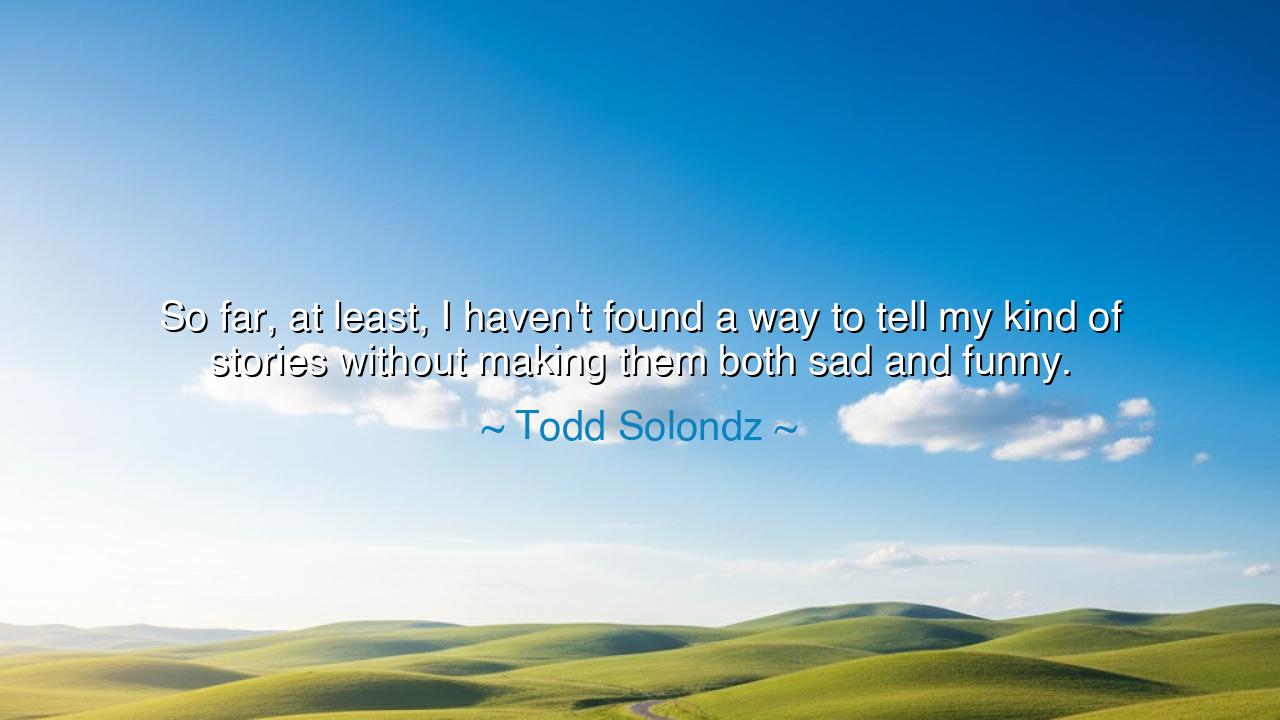
So far, at least, I haven't found a way to tell my kind of
So far, at least, I haven't found a way to tell my kind of stories without making them both sad and funny.






Hear the words of Todd Solondz, who unveils the paradox at the heart of his art: “So far, at least, I haven’t found a way to tell my kind of stories without making them both sad and funny.” In this declaration lies a truth as old as humanity itself—that life cannot be separated into clean chambers of joy and sorrow. Instead, it weaves the two together in a tapestry that is by turns heartbreaking and absurd, tragic and hilarious. To tell stories honestly, one must embrace both, for they exist not in opposition, but in union.
The meaning of his words is profound. The sadness in stories reveals the frailty of the human condition: our losses, our failures, our loneliness. But the funny element—often absurd, sometimes awkward, sometimes cruel—reminds us that even in our darkest moments, there is irony, there is foolishness, there is a laugh waiting to break through the tears. Solondz acknowledges that to capture the truth of life, one cannot choose only one side; the mirror must reflect both light and shadow.
The ancients knew this intimately. The Greeks birthed both tragedy and comedy, often within the same breath. Consider the works of Euripides, whose plays such as Alcestis carried scenes of devastating grief, yet also moments of humor that startled audiences. They understood that laughter and sorrow spring from the same well of human vulnerability. To laugh in the face of sorrow is not denial—it is survival. Solondz, like those ancient dramatists, shows that true storytelling cannot cut itself free from either root.
History gives us many examples. Think of Charlie Chaplin, the great silent film actor, whose comedies often played upon the edge of despair. In The Kid, a tramp raises an abandoned child in poverty, and while audiences laughed at the slapstick antics, they also wept at the tenderness of love and the cruelty of a heartless world. Chaplin, like Solondz, wove sadness and humor together, proving that the greatest stories are not one-note songs, but symphonies of contradiction.
What Solondz reminds us is that laughter and sorrow are not enemies, but companions. Funny moments give us relief, a breath of air in the depths of pain, while sad moments remind us that laughter alone is hollow without the weight of truth. Together, they capture the full measure of life. To deny this blend is to tell only half the story of what it means to be human.
The lesson, O seeker, is this: do not fear the mingling of emotions. Do not believe that to be sorrowful is to lack joy, nor that to laugh is to betray your grief. Life is both. When you tell your own stories, whether in art or in memory, do not strip them of contradiction. Speak of tears, but also of the moments you laughed through them. For in that balance lies authenticity, and authenticity is the soul of wisdom.
Practical is this counsel: when hardship comes, allow yourself to find humor even there, for it will sustain you. And when joy fills your heart, do not forget to honor the sorrow that taught you to value it. If you are a storyteller, an artist, or simply a traveler through life, weave both threads together. Let your life be a tale that is sad and funny, tragic and light, as all true tales must be.
Thus Todd Solondz’s words resound as a reminder of life’s duality: “I haven’t found a way to tell my kind of stories without making them both sad and funny.” Let us embrace this paradox not as flaw, but as wisdom. For the laughter that rises from sorrow is the most human sound of all, and the story that holds both is the story that endures.






AAdministratorAdministrator
Welcome, honored guests. Please leave a comment, we will respond soon